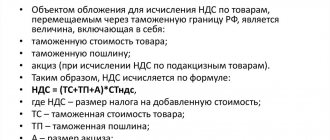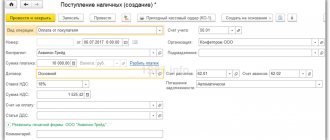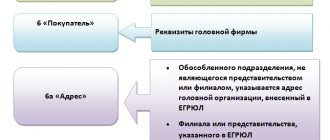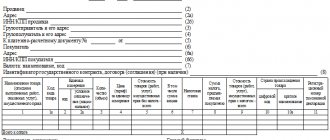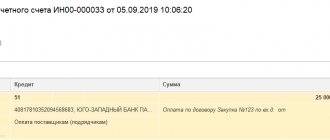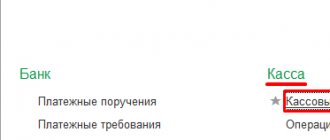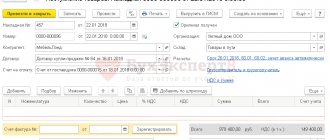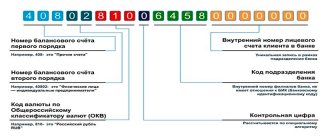What is an invoice
An invoice is the main accounting document confirming the fact of shipment of goods or provision of services at a specified cost.
This is not the only function of this form. It plays a major role in confirming the amount of VAT both on the sale of goods (services) and on input VAT to prove the right to a tax deduction in order to avoid double taxation. Clause 3 of Article 169 of the Tax Code of the Russian Federation states what an invoice is and why it is needed - all VAT payers for taxable transactions must draw up these documents. IMPORTANT!
The presence of an invoice is a prerequisite for crediting the amount of VAT on material resources (work, services) that were purchased by the taxpayer.
This is a very important document, often used in legal disputes, so it must be filled out correctly.
IMPORTANT!
A new invoice form has been approved since 07/01/2021 by Decree of the Government of the Russian Federation dated 04/02/2021 No. 534. The amendments are related to the introduction of a traceability system for imported goods.
Is there an alternative?
A recently emerged alternative to an invoice is the Universal Transfer Document. In this case, there are two versions of the new financial document , slightly different from each other. A UPD with status 1 can immediately replace an invoice, invoice and act. UPD with status 2 replaces only the act or invoice.
Using such a universal document greatly simplifies record keeping. At the same time, there have been cases when buyers refused to accept such a document, demanding to provide the usual invoice.
But, as the Ministry of Finance explained, such a requirement is incorrect, and the use of UTD instead of an account is completely legal . Both tax officials and buyers are required to accept such a document.
Thus, an invoice is mandatory for all VAT payers (except for the cases indicated above). Only a correctly drawn up invoice or UPD allows the taxpayer company to further exercise its rights to tax deductions.
Who prepares invoices
The document is presented by the seller (contractor, performer) to the buyer or customer. Drawing up this form is mandatory for business entities engaged in the sale of goods, performance of work or provision of services.
The following are required to prepare an invoice:
- individual entrepreneurs and legal entities subject to the general taxation system (unless their services fall under the exceptions established by clause 2 of Article 149 of the Tax Code of the Russian Federation);
- Individual entrepreneurs and organizations that partially work for OSN (for relevant types of activities).
Taxpayers who have chosen the simplified taxation system or the patent system as their taxation system are exempt from paying VAT, with the exception of certain cases. But if an organization or individual entrepreneur enjoys VAT exemption under Art. 145, 145.1 of the Tax Code of the Russian Federation, but performs transactions that are not exempt from tax, a new invoice is drawn up from July 1, 2022, marked “Without VAT” (clause 5 of Article 168 of the Tax Code of the Russian Federation, letter of the Ministry of Finance of Russia dated May 24, 2013 No. 03 -07-09/18686). This is necessary if there is interaction with organizations and individual entrepreneurs that are VAT payers. In addition, the parties have the right to apply the invoice on their own initiative.
Consequences of issuing a simplified invoice
In paragraph 3 of Art. 169 of the Tax Code of the Russian Federation directly states that only VAT payers are required to prepare invoices. Consequently, organizations and individual entrepreneurs using the simplified tax system should not create them when selling goods (works, services), property rights.
For your information
The “simplified” cannot take into account the amount of VAT paid in the tax base:
- nor as part of expenses (if the single tax is calculated from the difference between income and expenses), since according to paragraphs. 22 clause 1 art. 346.16 of the Tax Code of the Russian Federation, the amounts of VAT paid to the budget on the basis of clause 5 of Art. 173 of the Tax Code of the Russian Federation, are not subject to inclusion in expenses;
- neither as part of income, since according to paragraph 1 of Art. 248, paragraph 1, art. 346.15 of the Tax Code of the Russian Federation, when determining income, the amounts of taxes that are presented to the buyer are excluded from them.
At the same time, tax legislation does not formally prohibit a “simplified” person from issuing an invoice with the VAT amount highlighted on a separate line and presenting it to the buyer. This means that persons who are not payers of this tax, due to certain circumstances, have the right to independently decide whether to present the buyer of goods (works, services) with an indirect tax for payment or not. But they will have to answer for such “independence”.
Invoice deadlines
The general rule is as follows: an invoice is issued within 5 days from the date of transfer (shipment) of goods, performance of work or provision of services. Days are counted as calendar days. This norm is enshrined in paragraph 3 of Art. 168 Tax Code of the Russian Federation. The rules are the same for both paper and electronic invoices. Also, according to paragraph 3 of Art. 168 of the Tax Code of the Russian Federation, when preparing advance documents, this form is drawn up within the same 5 calendar days, but from the moment of receipt of payment for future deliveries, performance of work, provision of services.
Can a “simplified” issue an invoice with o?
As stated in paragraph 5 of Art. 168 Tax Code of the Russian Federation and paragraphs. “g” clause 2 of the Rules for filling out an invoice, persons released in accordance with Art. 145 of the Tax Code of the Russian Federation from the performance of duties as a VAT payer, invoices are drawn up without highlighting VAT: they make an appropriate inscription or put a stamp “Without tax (VAT)”.
Can a “simplified” person issue such an invoice? We believe not.
By virtue of paragraphs. 2 p. 2 art. 18 of the Tax Code of the Russian Federation The simplified tax system refers to special tax regimes, therefore, organizations and individual entrepreneurs that have switched to this special regime are not covered by the general system of VAT benefits established by Art. 145 Tax Code of the Russian Federation. Consequently, provided for in paragraph 5 of Art. 168 Tax Code of the Russian Federation and paragraphs. “g” clause 2 of the Rules for filling out an invoice, they cannot use the preference to issue an invoice indicating “Without tax (VAT)” (see, for example, Resolution of the AS VSO dated 04/12/2018 No. Ф02-1385/2018 on the case No. A19-13739/2017).
When an invoice is not needed
The legislation specifies cases when an invoice is not a mandatory document, and the completion and execution of a transaction is confirmed by other data: an invoice, an invoice for payment. Based on the regulations, the invoice is not filled out under the following circumstances:
- the transaction is not subject to VAT (Articles 149 and 169 of the Tax Code of the Russian Federation);
- when selling goods for cash (in this case, a check or a strict reporting form is sufficient);
- when applying simplified taxation regimes;
- a legal entity - the employer transfers the goods to its employee without providing counterpayment, that is, free of charge (according to the letter of the Ministry of Finance of the Russian Federation dated 02/08/2016 No. 03-07-09/6171);
- when sending goods taxed at a zero rate for export, if the buyer is not a VAT payer, if the shipment took place no later than 5 calendar days from the date of receipt of the advance payment (according to the letter of the Ministry of Finance of Russia dated January 18, 2017 No. 03-07-09/1695).
Types of invoices
There are three main types of invoice:
- ordinary, shipping. This document confirms that the goods have been transferred. This is the most common type of invoice, but legislation provides for more than just one;
- advance payment, written out and drawn up upon concluding a contract and receiving an advance payment for work performed or services rendered. This form does not confirm the fact of transfer;
- adjustment, filled in when the price or quantity of shipped products changes.
Legislative regulation of the content of invoices
The concept of invoice is enshrined in Art. 169 of the Tax Code of the Russian Federation. The form was approved by Decree of the Government of the Russian Federation dated December 26, 2011 No. 1137. But in 2013, the Federal Tax Service Inspectorate recommended using a universal transfer document developed on the basis of the approved form. The form must contain details in accordance with the Tax Code of the Russian Federation; adding additional details that are optimal for the seller and buyer should not affect the validity of the document.
IMPORTANT!
From 07/01/2021, taxpayers and tax agents who carry out transactions with traceable goods must issue and receive electronic invoices using an enhanced qualified electronic signature. Any invoice for products shipped to the buyer is registered in the traceability system, and it indicates a unique batch number assigned by the Federal Tax Service.
Responsibilities of a VAT payer
Under this phrase the provisions of Ch. 21 of the Tax Code of the Russian Federation imply a set of the following mandatory actions of the taxpayer.
| Responsibilities of a VAT payer | Decoding |
| Issue an invoice to the buyer in the form given in Appendix 1 to Decree of the Government of the Russian Federation dated December 26, 2011 No. 1137 | When selling goods (work, services), property rights, in addition to their price (tariff), the seller must present for payment to the buyer a certain amount of indirect tax (Article 168 of the Tax Code of the Russian Federation), which is calculated for each type of goods (work, services), property rights as a percentage of the prices (tariffs) agreed upon by the parties corresponding to the tax rate (clause 1 of Article 166 of the Tax Code of the Russian Federation) |
| Maintain invoice journals, sales and purchase books | The seller is obliged to register issued invoices in the sales book (and received ones in the purchase book) and the log of received and issued invoices (clauses 3 and 3.1 of Article 169 of the Tax Code of the Russian Federation) |
| Declaring VAT | The seller is obliged to submit VAT returns to the tax authority within the prescribed period (no later than the 25th day of the month following the expired quarter) in the manner prescribed by Art. 174 of the Tax Code of the Russian Federation: in electronic form via TKS channels |
Invoice details
What does the invoice form look like? This is a table with columns about the product and a header providing information about the parties to the contract.
Required invoice details:
- number and date;
- name, address and TIN, checkpoint of the buyer and seller, consignor and consignee, if any (please note, according to the new rules, the address must be written strictly as it is indicated in the Unified State Register of Legal Entities, check on the Federal Tax Service website in the “Check yourself and the counterparty” section);
- number of the payment document if an advance has been received for future deliveries;
- product name and unit of measurement;
- quantity;
- currency (ruble code - 643, US dollar - 840, euro - 978);
- price per unit of measurement;
- full cost;
- excise tax amount;
- tax rate;
- the amount of tax to be paid;
- total cost including taxes;
- country of origin of the goods (codes are set in accordance with the OK classifier (MK (ISO 3166) 004-97) 025-2001; if the goods are produced in Russia, a dash is added;
- customs declaration number (if the goods were not produced in Russia);
- signatures of the manager and chief accountant (or an authorized person - by order or power of attorney) - on a paper document; enhanced qualified digital signature - on electronic.
Invoice Line
“Identifier of a government contract, agreement (agreement)” is used in the case of supplies under a government contract. The filling rules specifically indicate that the line is filled only if there is an identifier. If absent, the line remains blank (there is no need to put a dash).
Filling out an invoice line by line
Rules for filling out an invoice line by line:
- the first line is the serial number of the document in accordance with the established document flow rules;
- the date of preparation is not earlier than the date of the original document;
- date and correction number are filled in if necessary;
- in the line “Seller” the full or abbreviated name is indicated in accordance with the constituent documents;
- the postal address is indicated in the “Address” line;
- in line 3, “same person” is entered if the seller and the shipper are the same person. Otherwise, you must provide the shipper's mailing address. When filling out an invoice for services and property rights, a dash is placed in this line;
- in term 4, according to the same rules, the data of the consignee is written;
- in line 5 “to the payment and settlement document” a dash is placed if the form is drawn up upon receipt of payment, partial payment or for upcoming deliveries using a non-cash form of payment;
- for line 7, the currency codes are given above.
The columns are filled in as follows:
- Column 1 indicates the name of the product or service provided;
- in column 2 - unit of measurement, if possible. A dash is placed upon receipt of payment or partial payment for upcoming deliveries. Columns 2 and 2a are filled out taking into account the All-Russian Classifier of Units of Measurement, introduced by Decree of the State Standard of the Russian Federation dated December 26, 1994 No. 366;
- Column 3 indicates the quantity or volume of the goods. If this indicator is not defined or is missing, you must put a dash. A dash is also added when payment or partial payment is received for upcoming deliveries;
- Column 4 (product price) is filled out according to similar rules;
- in column 6, if there is no excise tax amount, a corresponding note is made;
- in column 7 (tax rate) for transactions specified in paragraph 5 of Article 168 of the Tax Code of the Russian Federation, an entry “without VAT” is made;
- Column 8 is filled out according to similar rules;
- Columns 10-12 are filled in if the country of origin of the goods is not Russia, in accordance with the OK of the countries of the world (MK (ISO 3166) 004-97), - 025–2001.
This is what a completed invoice looks like:
If the form is an advance or correction form, this should be indicated in the document. As well as what changes are made to the form and on what basis. It depends on the agreement of the parties whether a stamp is placed on the invoice - it is not a mandatory detail, but is more often placed (for example, at the request of the buyer) if the legal entity issuing the document uses it according to the charter.
All forms are stored in chronological order for at least 4 years, recorded in the journal of received and issued invoices, in the book of purchases and sales in order to be able to verify the calculation and payment of VAT.
The main question: when is it better to issue an invoice?
The main question that arises in connection with the period allotted for issuing an invoice is the question of whether this period corresponds to the date indicated in the document. You usually have to choose from two options:
- The invoice is issued on the same date on which the shipping documents were issued or the advance was received. A 5-day period is needed here in order to create and sign it.
- An invoice can be issued on any date within 5 days from the date of shipment or receipt of advance payment. That is, the dates of the invoice and the supporting documents with which it is associated do not match.
It is better to issue an invoice on the same date as the supporting documents for the following reasons:
- The entire set of documents for a specific shipment will be very convenient to use. For individual documents, it will contain the same dates and totals.
- There will be no problems with accounting for VAT at the junction of periods when the shipment was made in one quarter, and the invoice for it is dated the next. Moreover, this problem will primarily affect the supplier himself, since he will reflect the sales in accounting in one quarter, and the VAT document will relate to another. At the same time, in the accounting program, the invoice will automatically, based on the date of creation of the VAT, go into the sales book of another quarter, and if you manually adjust the date of entry in the book, the program may refuse to record there a document dated later than the quarter of shipment.
- Advance invoices, the date of which will coincide with the date of receipt of money, will be convenient to use.
- The date of the adjustment invoice will coincide with the date of signing the agreement to change the quantity or price of the goods, which will also make it easier to work with these documents.
The need to match the dates of documents drawn up during mediation activities is indicated in Decree of the Government of the Russian Federation dated December 26, 2011 No. 1137.
Common Invoice Errors
Errors that are most often encountered when filling out an invoice and their consequences:
- if the name, TIN, and address of the organization are incorrectly indicated or missing, it is difficult to establish the authorship and addressee of the document, so it is declared invalid;
- if it is impossible to determine from the document what goods were transferred or service was provided, VAT will not be refunded;
- incorrect indication of currency, incorrect indication of the quantity of goods, errors in prices, incorrect calculation of cost lead to the fact that the exact cost of the goods cannot be determined. Thus, the document becomes uninformative;
- incorrect calculation of VAT. The absence of a VAT amount will raise questions from regulatory authorities.
Minor errors in the form of missing characters, capital letters, or inaccuracies in payment details are usually not pursued by the tax authorities. It is also possible to abbreviate names if such an abbreviation allows you to identify the enterprise or product.
Adjustment invoice
If the cost of shipped goods (work performed, services rendered, transferred property rights) changes, adjustment invoices are issued (clause 3 of Article 168 of the Tax Code of the Russian Federation). When making adjustments, the following rules must be observed:
- changes are made to both copies;
- changes must be endorsed by the seller’s manager or an authorized person (the signature of the chief accountant is not required) and certified by a seal;
- be sure to include a date for making corrections;
- erroneous data is crossed out and new ones are entered, indicating the column, and the explanation “Corrected” must be included.
If there are too many errors, create a new document. The norms of the Tax Code of the Russian Federation do not contain a ban on such an action.
New invoice form in 2022
The Ministry of Finance of Russia, by Order No. 14n dated 02/05/2021, approved a new procedure for issuing and receiving electronic invoices. And the Federal Tax Service of Russia has changed the form of the invoice. The composition of the invoice and adjustment invoice details was supplemented with new details:
- registration number of the batch of goods subject to traceability;
- quantitative unit of measurement of a product used for traceability purposes;
- the quantity of a product subject to traceability, in the quantitative unit of measurement of the product used for traceability purposes.
All changes came into force on 07/01/2021, when the new product traceability system became operational.
According to the new procedure, taxpayers and tax agents must issue and receive electronic invoices using an enhanced qualified electronic signature. Besides:
- EDF operators will be required to check received documents if such a condition is in the agreement with the seller;
- will implement a procedure for dealing with positive and negative test results.
The new procedure has been extended to all invoices issued under the goods traceability system.
Procedure and terms for issuing invoices in 2020-2021
The period for issuing an invoice is 5 calendar days, counted from the date of the event in connection with which the invoice is issued (clauses 1 and 2 of article 6.1, clause 3 of article 168 of the Tax Code of the Russian Federation), that is:
- shipments;
- advance receipts;
- changes in the quantity or price of goods shipped.
Whether the day of shipment, receipt of advance payment, etc. is considered when determining this 5-day period, see here.
The Tax Code of the Russian Federation does not establish deadlines for issuing an invoice in other situations requiring its preparation.
In this case, as a general rule, an invoice is issued for each event separately, but it is also possible to draw up one document for all shipments made to one buyer during the day (letter of the Ministry of Finance of Russia dated May 2, 2012 No. 03-07-09/44). If the shipment is continuous (energy resources, rent), then the invoice, as well as the shipping document, can be issued once per month or quarter (letter of the Ministry of Finance of Russia dated September 13, 2018 No. 03-07-11/65642, dated 06/25/2008 No. 07-05-06/142 and dated 02/17/2009 No. 03-07-11/41).
Find out when to issue an invoice for construction and installation work for your own consumption in ConsultantPlus. If you don't have access, get a free trial online.
In the first two cases (for shipment and advance payment), a regular invoice is drawn up, and in the third case (for a change in quantity or price), an adjustment invoice is drawn up.
From 07/01/2021 a new invoice form is in effect, incl. adjustment, as amended by the Decree of the Government of the Russian Federation dated 04/02/2021 No. 534. The update of the form was caused by the introduction of a goods traceability system. All taxpayers are required to use the new form, even if the goods are not included in the traceability system. Read more about the changes made to the document here.
You can download the new invoice form by clicking on the image below:
ConsultantPlus experts have prepared step-by-step instructions for preparing each line of the updated invoice. To do everything correctly, get trial access to the system and go to the Ready solution. It's free.
For more information about the purpose of an adjustment invoice, read the material “What is an adjustment invoice and when is it needed?” .
